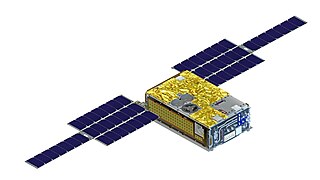Related Research Articles

Aeolus, or, in full, Atmospheric Dynamics Mission-Aeolus (ADM-Aeolus), was an Earth observation satellite operated by the European Space Agency (ESA). It was built by Airbus Defence and Space, launched on 22 August 2018, and operated until it was deorbited and re-entered the atmosphere over Antarctica on 28 July 2023. ADM-Aeolus was the first satellite with equipment capable of performing global wind-component-profile observation and provided much-needed information to improve weather forecasting. Aeolus was the first satellite capable of observing what the winds are doing on Earth, from the surface of the planet and into the stratosphere 30 km high.
The Living Planet Programme (LPP) is a programme within the European Space Agency which is managed by the Earth Observation Programmes Directorate. LPP consists of two classes of Earth observation missions including research missions known as Earth Explorers, and the Earth Watch class of missions whose objective is to develop support operational applications such as numerical weather forecasting or resource management.

EarthCARE, nicknamed Hakuryū, is a joint European/Japanese satellite, the sixth of ESA's Earth Explorer Programme. The main goal of the mission is the observation and characterization of clouds and aerosols as well as measuring the reflected solar radiation and the infrared radiation emitted from Earth's surface and atmosphere.
LuxSpace is a European space systems contractor based in Betzdorf in Luxembourg. It was founded in November 2004 as a daughter company of OHB AG, and began operations in January 2005.
SEOSat-Ingenio, was a Spanish project to produce a satellite capable of providing wide-field imagery ensuring a repeat cycle of 38 days at 2.5 metre panchromatic resolution and 10 metre colour resolution, from a Sun-synchronous polar orbit; it was Spain's first optical imaging satellite. The satellite was part of the Spanish Earth Observation Satellite program. The mission was funded by Spain's Centre for the Development of Industrial Technology (CDTI). SEOSat-Ingenio information was to be used by various Spanish civil, institutional or government users. However, under the Copernicus Programme of the European Union, it was also accessible to other European users, as well as to the Group on Earth observation of the Global Observing System of Earth.
Secondary payload, also known as rideshare payload, is a smaller-sized payload transported to orbit on a launch vehicle that is mostly paid for—and with the date and time of launch and the orbital trajectory determined—by the entity that contracts and pays for the primary launch. As a result, the secondary payload typically obtains a substantially reduced price for transportation services to orbit, by accepting a trade off of the loss of control once the contract is signed and the payload is delivered to the launch vehicle supplier for integration to the launch vehicle. These tradeoffs typically include having little or no control over the launch date/time, the final orbital parameters, or the ability to halt the launch and remove the payload should a payload failure occur during ground processing prior to launch, as the primary payload typically purchases all of these launch property rights via contract with the launch services provider.

Planet Labs PBC is a publicly trading American Earth imaging company based in San Francisco, California. Their goal is to image the entirety of the Earth daily to monitor changes and pinpoint trends.

Soyuz at the Guiana Space Centre was a European Space Agency (ESA) programme that operated Soyuz-2 launch vehicles at the Guiana Space Centre (CSG). It provided Arianespace with a medium-lift launch vehicle alongside the light-lift Vega and heavy-lift Ariane 5. The rocket was marketed by Starsem a joint venture of ArianeGroup, Arianespace, Progress Rocket Space Centre and Roscosmos.

ArgoMoon is a CubeSat that was launched into a heliocentric orbit on Artemis 1, the maiden flight of the Space Launch System, on 16 November 2022 at 06:47:44 UTC. The objective of the ArgoMoon spacecraft is to take detailed images of the Interim Cryogenic Propulsion Stage following Orion separation, an operation that will demonstrate the ability of a cubesat to conduct precise proximity maneuvers in deep space. ASI has not confirmed nor denied whether this took place, but several images of the Earth and the Moon were taken.

EQUULEUS is a nanosatellite of the 6U CubeSat format that will measure the distribution of plasma that surrounds the Earth (plasmasphere) to help scientists understand the radiation environment in that region. It will also demonstrate low-thrust trajectory control techniques, such as multiple lunar flybys, within the Earth-Moon region using water steam as propellant. The spacecraft was designed and developed jointly by the Japan Aerospace Exploration Agency (JAXA) and the University of Tokyo.
Biomass is an Earth observing satellite planned for launch by the European Space Agency (ESA) in 2025 from Kourou, French Guiana on a on a Vega-C launch vehicle.

ISISPACE (Innovative Solutions In Space) is a Dutch NewSpace company based in Delft dedicated to the design, manufacture and operation of CubeSats.
ION Satellite Carrier is a satellite platform developed, manufactured, and operated by Italian company D-Orbit. The platform features a customizable 64U satellite dispenser capable of hosting a combination of CubeSats that fits the volume. Throughout a mission, ION Satellite Carrier can release the hosted satellites individually, changing orbital parameter between one deployment and the next. Each of the miniature CubeSats weighs a few kilograms.

Vega flight VV15 was the 15th flight of the Vega launcher, and its first failure.

This article documents expected notable spaceflight events during the year 2027.

Vega flight VV16, also called SSMS PoC Flight, was the 16th launch of the Vega rocket. The launch was also notable as it was the first Vega launch following the accident of the VV15 launch in July 2019 that caused the loss of FalconEye1 satellite.
Phi-Sat-1 is a CubeSat mission from the European Space Agency (ESA) that uses Artificial Intelligence (AI) for Earth observation. The mission will collect a large number images from space in the visible, near-infrared and thermal-infrared parts of the electromagnetic spectrum, and then filter out the images which are covered with clouds using AI algorithms. This reduces the number of images to be downlinked from space and therefore improve efficiency. The Phi-Sat-1 mission has two main objectives:
References
- 1 2 3 Caramelli, F; Battie, F; Scaccia, A (1 August 2019). "The first Vega ride-share mission flight" (PDF). Utah State University . Retrieved 22 September 2020.
- 1 2 3 4 Nanuam, Wassana (16 June 2020). "Napa-1 satellite finally readies for Friday launch". Bangkok Post . Retrieved 22 September 2020.
- 1 2 "ISIS selected by the Royal Thai Air Force to realize a complete 6U mission for Earth Observation". 7 September 2018. Retrieved 22 September 2020.
- ↑ Henry, Caleb (3 September 2020). "Arianespace launches Vega on return-to-flight mission with 53 smallsats". SpaceNews . Retrieved 22 September 2020.
- 1 2 "ทำความรู้จัก "นภา-1" ดาวเทียมดวงแรกของทัพอากาศไทย". PPTVHD36 (in Thai). 18 June 2020. Retrieved 22 September 2020.
- ↑ "Packing completed: NAPA-1 satellite is ready for launch". 12 February 2020. Retrieved 22 September 2020.